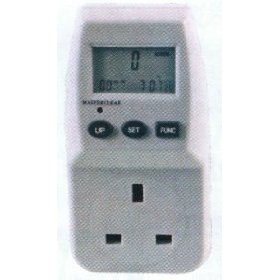- Joined
- 27 Jan 2008
- Messages
- 27,674
- Reaction score
- 3,349
- Location
- Llanfair Caereinion, Nr Welshpool
- Country

Since the meter clipped onto the incoming tails measures all it is hard to isolated what items are drawing more than their fair share.
Fridge, Freezer, Dish washer, Washing machine do not draw a simple x amps but time is a major factor and one needs to monitor over a set time to identify which is taking over it's far share.
The freezer is a real problem air circulation, room temperature, insulation quality, efficiency of compressor, and de-frost cycle will all alter how much power it uses. Insulation quality is a major problem but you need something to compare it with. This is where I found the problem. Over 24 hours it uses X joules will actually shows kWh which seems an odd unit but still does not matter what the unit is you need to know if that is high or low.
Even the washing machine drum size, and wash method vary so with water jets as well as tumble it may clean with cooler and less water than simple tumble so kWh for a 10kg load will vary a lot but unless you can find a site which states how many kWh a 10kg load of jeans worn by men working in an office should require there are so many variables it is near impossible to compare your machine to new state of the art.
There is also things like spin speed. Finish off on the washing line and does not matter if 3 hours or 6 hours to dry but transfer to a tumble dryer and the washing machine spin speed can save you loads of money but not with how much washing machine uses but in how much tumble drier uses.
The tumble drier drawing air from outside and returning it to outside would be easy to compare with one drawing from inside and returning to inside but many draw from inside and vent outside so you need to factor cost to heat that air with central heating.
A simple vent bringing dry cold air into tumble drier intake can save loads of money.
But with all these examples step one is to measure individually what power they use. A meter measuring the lot is near useless in trying to work it all out.
Next is a degree in maths but simple measure two washing machines, two freezers etc is the way to work out what items need replacing and what are good enough not to worry about.
OK comparing an induction hob with a gas hob is a bit much but start simple.
Fridge, Freezer, Dish washer, Washing machine do not draw a simple x amps but time is a major factor and one needs to monitor over a set time to identify which is taking over it's far share.
The freezer is a real problem air circulation, room temperature, insulation quality, efficiency of compressor, and de-frost cycle will all alter how much power it uses. Insulation quality is a major problem but you need something to compare it with. This is where I found the problem. Over 24 hours it uses X joules will actually shows kWh which seems an odd unit but still does not matter what the unit is you need to know if that is high or low.
Even the washing machine drum size, and wash method vary so with water jets as well as tumble it may clean with cooler and less water than simple tumble so kWh for a 10kg load will vary a lot but unless you can find a site which states how many kWh a 10kg load of jeans worn by men working in an office should require there are so many variables it is near impossible to compare your machine to new state of the art.
There is also things like spin speed. Finish off on the washing line and does not matter if 3 hours or 6 hours to dry but transfer to a tumble dryer and the washing machine spin speed can save you loads of money but not with how much washing machine uses but in how much tumble drier uses.
The tumble drier drawing air from outside and returning it to outside would be easy to compare with one drawing from inside and returning to inside but many draw from inside and vent outside so you need to factor cost to heat that air with central heating.
A simple vent bringing dry cold air into tumble drier intake can save loads of money.
But with all these examples step one is to measure individually what power they use. A meter measuring the lot is near useless in trying to work it all out.
Next is a degree in maths but simple measure two washing machines, two freezers etc is the way to work out what items need replacing and what are good enough not to worry about.
OK comparing an induction hob with a gas hob is a bit much but start simple.




